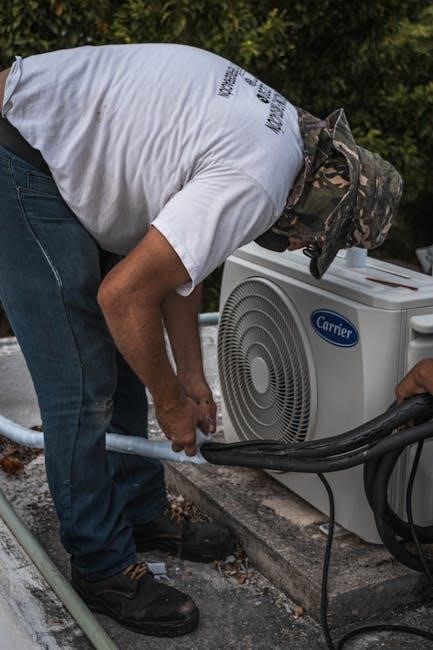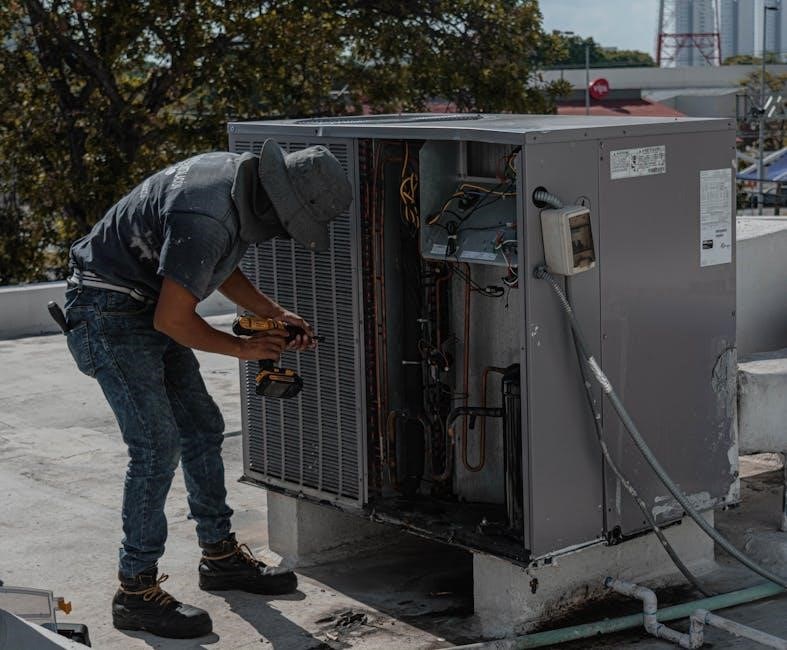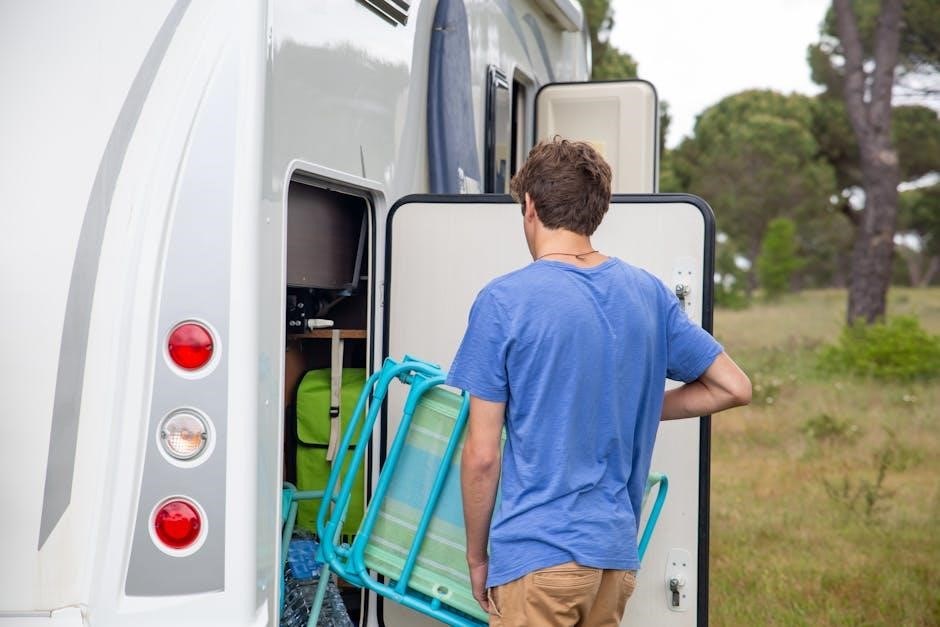Welcome to the Dometic RV Air Conditioner Manual, a comprehensive guide for installation, operation, and maintenance. Designed for RV owners and qualified technicians, it ensures safety, efficiency, and optimal performance while troubleshooting common issues.
Purpose of the Manual
The purpose of this manual is to provide detailed instructions for the safe and efficient installation, operation, and maintenance of the Dometic RV air conditioner. It serves as a comprehensive resource for both RV owners and qualified technicians, ensuring optimal performance and troubleshooting common issues. The manual outlines essential safety precautions, technical specifications, and step-by-step installation processes. It also covers routine maintenance tasks, humidity management, and tips for achieving desired temperature settings. By following the guidelines in this manual, users can extend the lifespan of their air conditioner and ensure consistent comfort within their RV. This guide is designed to be user-friendly, offering clear instructions for all aspects of the unit’s operation and care.

Scope of the Manual

The scope of this manual encompasses all aspects of the Dometic RV air conditioner, including installation, operation, and maintenance. It covers technical specifications, safety guidelines, and troubleshooting procedures. The manual is divided into sections, each addressing specific topics such as choosing the proper installation location, step-by-step installation processes, and post-installation checks. It also includes detailed information on operating modes, temperature control, and humidity management. Maintenance tasks, such as cleaning air filters and condenser coils, are thoroughly explained. Additionally, the manual provides troubleshooting solutions for common issues and offers guidelines for ensuring the structural integrity of the RV roof. It is designed to be a complete reference for both users and technicians, ensuring that all necessary information is readily available for optimal performance and longevity of the unit.
Target Audience (Users and Technicians)
This manual is designed for two primary audiences: RV owners and users seeking to understand and operate their Dometic air conditioner effectively, and qualified technicians involved in installation, maintenance, or repair. For users, the manual provides clear guidance on operating modes, temperature control, and humidity management, ensuring a comfortable RV environment. It also outlines routine maintenance tasks to keep the unit running efficiently. For technicians, the manual offers detailed installation instructions, technical specifications, and troubleshooting procedures to diagnose and resolve mechanical or electrical issues. The content is structured to cater to both groups, ensuring that all necessary information is accessible and easy to understand. Whether you’re a homeowner or a professional, this manual serves as a complete resource for optimizing the performance and longevity of the Dometic RV air conditioner.

Installation Instructions
This section provides a detailed guide for installing the Dometic RV air conditioner, including proper placement, securing the unit, and essential safety precautions to ensure a safe and efficient setup.
Choosing the Proper Location for the Unit
Proper placement of the Dometic RV air conditioner is crucial for optimal functionality and even air distribution. The unit should be installed centrally on the RV roof to ensure balanced airflow throughout the interior. Additionally, the front of the unit must face the correct direction to align with the RV’s layout. This central positioning helps in reducing hot spots and ensures consistent cooling. Avoid areas with obstructions or uneven surfaces, as they can hinder installation stability. Always follow the manufacturer’s guidelines to ensure structural integrity and proper sealing to prevent leaks. Proper location selection is the first step toward a successful installation and efficient operation.
Step-by-Step Installation Process
Begin by turning off the RV’s power supply and removing the rain cover from the air conditioner. Carefully lift the unit onto the roof, ensuring it is centered and aligned properly. Secure the unit using the provided bolts, tightening them evenly to avoid damaging the roof. Connect the electrical components, following the wiring diagram in the manual. Ensure all connections are snug and waterproof. Replace the rain cover and seal any gaps around the unit to prevent leaks. Finally, test the air conditioner by turning it on and checking for proper airflow and cooling performance. Always refer to the manual for specific torque values and safety precautions to ensure a secure and functional installation.
Post-Installation Checks and Tests
After installation, ensure the air conditioner is level and securely fastened to the RV roof. Inspect the sealing around the unit to prevent water leaks. Turn on the power and test all modes to confirm proper operation. Check for any unusual noises or vibrations. Verify that electrical connections are secure and meet the specified voltage requirements. Test the thermostat by adjusting the temperature to ensure accurate cooling. Inspect the condenser coils for blockages and ensure proper airflow; Finally, monitor the unit’s performance over several hours to identify any potential issues. These checks ensure the air conditioner functions efficiently and safely, providing reliable cooling for your RV.
Operating the Dometic RV Air Conditioner involves selecting modes like cooling, heating, or fan-only, adjusting temperature settings, and managing humidity for a comfortable environment. Always follow manual guidelines for optimal performance.

Air Conditioning Modes
The Dometic RV Air Conditioner offers multiple operating modes to suit different climate conditions. These include cooling mode for lowering the temperature, heating mode for maintaining warmth, and fan-only mode for circulating air without cooling or heating. Additionally, a dehumidify mode is available to remove excess moisture from the RV, preventing condensation and improving comfort. Each mode is designed to address specific needs, ensuring efficient operation and energy savings. The manual provides detailed instructions on how to switch between modes and adjust settings for optimal performance. Proper use of these modes ensures a comfortable indoor environment, regardless of external weather conditions.

Temperature Control and Settings
The Dometic RV Air Conditioner features advanced temperature control systems, allowing users to set their desired indoor climate precisely. The unit is equipped with a programmable thermostat that enables easy adjustment of cooling and heating settings. Users can select from a range of temperatures, ensuring optimal comfort in various weather conditions. The system also includes automatic temperature sensors that monitor and adapt to changes in the RV’s environment. For energy efficiency, the air conditioner can be programmed to maintain a consistent temperature, reducing power consumption when the RV is unoccupied. Proper use of these settings ensures balanced humidity levels and prevents condensation buildup, enhancing overall comfort and system longevity. Always refer to the manual for detailed instructions on configuring temperature settings for your specific needs.
Humidity Management in the RV
Managing humidity is crucial for comfort and preventing moisture-related issues in your RV. The Dometic RV Air Conditioner is designed to remove excess moisture from the air, reducing humidity levels and preventing condensation buildup on windows and surfaces. High humidity can lead to sweating inside the RV, especially in cooler environments, which can damage interiors and create unpleasant conditions. The air conditioner’s dehumidification mode helps maintain a balanced indoor climate, ensuring a dry and comfortable living space. Regular use of the air conditioner, along with proper ventilation, is essential to manage humidity effectively. This feature not only enhances comfort but also protects your RV from mold and mildew growth, ensuring a fresh and healthy environment for occupants.

Maintenance and Care
Regular maintenance ensures optimal performance and longevity of your Dometic RV air conditioner. Clean filters, inspect coils, and check for leaks to maintain efficiency and prevent issues.
Routine Maintenance Tasks
Regular maintenance is crucial for the optimal performance of your Dometic RV air conditioner. Start by inspecting and cleaning the air filter every 30 days to ensure proper airflow. Check the condenser coils monthly and clean them as needed to prevent dust buildup. Drain the condensate water regularly to avoid leaks and water damage. Inspect the refrigerant lines for any signs of wear or leaks and replace them if necessary. Additionally, lubricate the fan motors annually to maintain smooth operation. Finally, ensure the roof seals are tight to prevent air leaks and water ingress. By following these routine tasks, you can extend the lifespan of your unit and maintain its efficiency.
Cleaning the Air Filter and Condenser Coils
Cleaning the air filter and condenser coils is essential for maintaining the efficiency and performance of your Dometic RV air conditioner. Start by removing the air filter and gently vacuuming it with a soft-bristle brush to eliminate dust and debris. If the filter is washable, rinse it with mild soap and water, then allow it to dry completely before reinstalling. For the condenser coils, locate them on the exterior of the unit and brush off any visible dirt or obstructions. Use a garden hose on a low setting to rinse the coils, ensuring no water enters the electrical components. Regular cleaning prevents overheating and ensures proper airflow. Clean these components every 30 days or more frequently in dusty environments to maintain optimal cooling performance.
Deep Cleaning the Unit
Deep cleaning the Dometic RV air conditioner involves thorough maintenance to ensure long-term efficiency. Begin by disconnecting the power supply for safety. Remove the exterior cover and gently brush away debris from internal components like the evaporator and condenser coils. Use a mild detergent mixed with warm water to wipe down surfaces, paying attention to areas prone to mold or mildew. Inspect and clean the drain system to prevent water buildup, ensuring proper airflow. Reassemble the unit carefully after cleaning and test its operation to confirm everything functions correctly. Perform this deep cleaning process every 6 months or during the off-season to maintain optimal performance and prevent damage from accumulated dirt and moisture.

Troubleshooting Common Issues
Identify and resolve common issues like low airflow, water leakage, or electrical malfunctions; Refer to the manual for diagnostic steps and solutions. Always prioritize safety and consult a technician if unsure.
Common Problems and Solutions
Common issues with the Dometic RV air conditioner include low airflow, water leakage, and electrical malfunctions. Low airflow can often be resolved by cleaning the air filter or ensuring proper vent installation. Water leakage may indicate improper drainage or condenser coil blockage, requiring immediate attention to prevent damage. Electrical issues, such as the unit not turning on, may stem from faulty wiring or a blown fuse. Always refer to the manual for diagnostic steps and solutions. If problems persist, consult a qualified technician to avoid further complications. Regular maintenance, such as cleaning filters and inspecting drainage systems, can help prevent these issues. Addressing problems promptly ensures reliable performance and extends the unit’s lifespan.
Diagnosing Electrical and Mechanical Issues
Diagnosing electrical and mechanical issues in the Dometic RV air conditioner involves a systematic approach. Start by checking the power supply and circuit breakers to ensure the unit is receiving electricity. Inspect wiring connections for damage or corrosion, and verify that all components are securely connected; For mechanical issues, examine the compressor, fan motor, and condenser coils for blockages or damage. Use a multimeter to test electrical components like capacitors and relays. If the unit is not cooling, check for refrigerant leaks or blockages in the airflow. Always turn off the power before performing any diagnostics. If issues persist, consult the manual or contact a certified technician. Regular inspections can help identify and resolve problems early, ensuring reliable operation and extending the unit’s lifespan.

Technical Specifications
The Dometic RV air conditioner is designed for roof installation, with electrical requirements of 120V/60Hz and a four-bolt mounting system. Physical dimensions and weight vary by model, ensuring compatibility with most RV systems.
Electrical Requirements and Compatibility
The Dometic RV air conditioner operates on a standard 120V AC power supply at 60Hz, ensuring compatibility with most RV electrical systems. It requires a dedicated 20-amp circuit to function efficiently. The unit is designed to be energy-efficient, minimizing power consumption while maintaining optimal cooling performance. For proper installation, the air conditioner must be connected to a grounded electrical outlet to ensure safety. Compatibility with various RV models is guaranteed, as the system is engineered to integrate seamlessly with existing electrical setups. Always consult the manual for specific voltage and current requirements, as these may vary slightly depending on the model. Proper electrical connections are crucial for both performance and safety.
Physical Dimensions and Weight
The Dometic RV air conditioner is designed to fit seamlessly on the roof of your recreational vehicle. Its compact dimensions ensure minimal space occupancy while providing maximum cooling efficiency. The unit typically measures approximately 40 inches in length, 29 inches in width, and 10 inches in height, making it suitable for most RV roof installations. The weight of the air conditioner is around 90 pounds, depending on the specific model and features. Proper mounting hardware is included to ensure secure installation and stability. These dimensions and weight are designed to maintain the structural integrity of the RV roof while providing reliable performance. Always refer to the specific model’s manual for exact measurements, as slight variations may occur between different models.

Safety Guidelines and Precautions
Always turn off power before installation or maintenance. Ensure the unit is securely installed to avoid damage. Follow all safety guidelines to prevent electrical or structural hazards.
Safety Warnings and Precautions
Ensure all safety guidelines are followed to prevent accidents and damage. Always turn off the power supply before performing any installation or maintenance tasks. Verify the structural integrity of the RV roof to support the air conditioner’s weight. Avoid creating low spots on the roof, as this can lead to water accumulation and structural weakness. Keep the area around the unit clear of obstructions to ensure proper airflow. Never operate the air conditioner if it is damaged or improperly installed. Be cautious of electrical components and avoid exposing them to moisture. Follow all manufacturer instructions carefully to prevent electrical or mechanical hazards. Regularly inspect the unit for signs of wear or damage. Proper ventilation is essential to avoid humidity buildup inside the RV. Failure to adhere to these precautions may result in unsafe operating conditions or system failure. Always prioritize safety to ensure reliable performance and longevity of the unit.
Structural Integrity of the RV Roof
Ensuring the structural integrity of the RV roof is crucial for safe and proper installation of the Dometic air conditioner. The roof must be strong enough to support the unit’s weight, especially under various weather conditions. Avoid creating low spots during installation, as they can lead to water pooling, which may weaken the roof structure over time. The installer must verify that the roof’s materials and design can handle the added load without compromising safety. Regular inspections should be conducted to check for any signs of stress or damage caused by the unit. If any issues arise, consult a professional to address them promptly. Maintaining the roof’s structural integrity ensures the air conditioner functions efficiently and safely, preventing potential hazards and extending the lifespan of both the RV and the unit. Proper installation and ongoing care are essential for reliability and performance.
The Dometic RV Air Conditioner Manual provides essential information for users and technicians, ensuring proper installation, operation, and maintenance. By following these guidelines, you can optimize performance, extend service life, and enjoy reliable cooling in your RV.
Final Tips for Optimal Performance
For optimal performance of your Dometic RV air conditioner, ensure regular maintenance tasks are performed. Clean the air filter and condenser coils frequently to prevent dust buildup and maintain airflow. Keep the roof unit covered when not in use to protect it from debris. Check the drain system regularly to avoid water accumulation, which can lead to humidity issues inside the RV. Properly insulate the RV to minimize heat gain and reduce the load on the air conditioner. Always follow the installation and operational guidelines provided in the manual to ensure safety and efficiency. By adhering to these tips, you can extend the lifespan of your unit and enjoy consistent cooling comfort during your travels.
